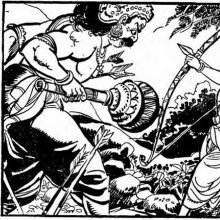Janasthana, Jana-sthana, Janasthāna: 12 definitions
Introduction:
Janasthana means something in Hinduism, Sanskrit, Marathi. If you want to know the exact meaning, history, etymology or English translation of this term then check out the descriptions on this page. Add your comment or reference to a book if you want to contribute to this summary article.
Images (photo gallery)
In Hinduism
Purana and Itihasa (epic history)
Source: archive.org: Puranic EncyclopediaJanasthāna (जनस्थान).—This is a part of the forest Daṇḍaka, which lies in the basin of the Godāvarī. Śrī Rāma had lived in this forest with Sītā and Lakṣmaṇa for a long time during the period of his forest-life. It was at this place that Śrī Rāma killed fourteen thousand Rākṣasas (giants) such as Khara Dūṣaṇa, Triśiras and others. (Mahābhārata Dākṣiṇātya Pāṭha, Sabhā Parva, Chapter 38). Mārīca allured Sītā and Rāvaṇa kidnapped her in this place. (Mahābhārata Vana Parva, Chapter 147). Śūrpaṇakhā tried to attract Śrī Rāma and Lakṣmaṇa, and her nose etc, were cut off, in this forest. It was in this place that Śrī Rāma cut off the head of a Rākṣasa (demon) and threw it away. That head fell in the lap of a hermit called Mahodara. (Mahābhārata Śalya Parva, Chapter 39). Janasthāna is regarded as a holy place. It is mentioned in Mahābhārata, Anuśāsana Parva, Chapter 25, Stanza 29, that those who stay in this place and take bath in the Godāvarī will acquire imperial prosperity.
Source: Cologne Digital Sanskrit Dictionaries: The Purana IndexJanasthāna (जनस्थान).—Here Rāma vanquished a host of Rākṣasas;1 and performed the work of gods.2

The Purana (पुराण, purāṇas) refers to Sanskrit literature preserving ancient India’s vast cultural history, including historical legends, religious ceremonies, various arts and sciences. The eighteen mahapuranas total over 400,000 shlokas (metrical couplets) and date to at least several centuries BCE.
Languages of India and abroad
Marathi-English dictionary
Source: DDSA: The Molesworth Marathi and English Dictionaryjanasthāna (जनस्थान).—n (S) The forest Danḍaka in the Dakhaṇ, the resort of hosts of demons. 2 Jocosely. A name for the city nāśika Nashik.
Marathi is an Indo-European language having over 70 million native speakers people in (predominantly) Maharashtra India. Marathi, like many other Indo-Aryan languages, evolved from early forms of Prakrit, which itself is a subset of Sanskrit, one of the most ancient languages of the world.
Sanskrit dictionary
Source: DDSA: The practical Sanskrit-English dictionaryJanasthāna (जनस्थान).—Name of a part of the Daṇḍakā forest; R.12.42;13.22; Uttararāmacarita 1.28;2.17.
Derivable forms: janasthānam (जनस्थानम्).
Janasthāna is a Sanskrit compound consisting of the terms jana and sthāna (स्थान).
Source: Cologne Digital Sanskrit Dictionaries: Shabda-Sagara Sanskrit-English DictionaryJanasthāna (जनस्थान).—n.
(-naṃ) The forest Dandaka, (in the Deccan) the eastern part. of it. E. jana a world, and sthān a place; the resort of a world of demons.
Source: Cologne Digital Sanskrit Dictionaries: Benfey Sanskrit-English DictionaryJanasthāna (जनस्थान).—n. the name of a wood, Utt Rāmac. 17, 12. Janmasthāna, i. e.
Janasthāna is a Sanskrit compound consisting of the terms jana and sthāna (स्थान).
Source: Cologne Digital Sanskrit Dictionaries: Cappeller Sanskrit-English DictionaryJanasthāna (जनस्थान).—[neuter] [Name] of a part of the Dandaka forest.
Source: Cologne Digital Sanskrit Dictionaries: Monier-Williams Sanskrit-English DictionaryJanasthāna (जनस्थान):—[=jana-sthāna] [from jana > jan] n. ‘resort of men’, Name of part of the Daṇḍaka forest in Deccan, [Mahābhārata iii, ix, xiii; Rāmāyaṇa; Raghuvaṃśa xii f.]
Source: Cologne Digital Sanskrit Dictionaries: Yates Sanskrit-English DictionaryJanasthāna (जनस्थान):—[jana-sthāna] (naṃ) 1. n. The forest Dandaka, or the eastern part of it.
[Sanskrit to German]
Sanskrit, also spelled संस्कृतम् (saṃskṛtam), is an ancient language of India commonly seen as the grandmother of the Indo-European language family (even English!). Closely allied with Prakrit and Pali, Sanskrit is more exhaustive in both grammar and terms and has the most extensive collection of literature in the world, greatly surpassing its sister-languages Greek and Latin.
Kannada-English dictionary
Source: Alar: Kannada-English corpusJanasthāna (ಜನಸ್ಥಾನ):—[noun] the old name for the region between the rivers Narmade and Gōdāvari in Central India.
Kannada is a Dravidian language (as opposed to the Indo-European language family) mainly spoken in the southwestern region of India.
See also (Relevant definitions)
Partial matches: Jana, Sthana.
Starts with: Janastanam, Janasthanaruha.
Query error!
Full-text: Janasthanaruha, Janastanam, Athida, Bhramari, Bhutapurvam, Nasika, Paridhaya, Alaya, Vimarda, Chad, Lok.
Relevant text
Search found 25 books and stories containing Janasthana, Jana-sthana, Jana-sthāna, Janasthāna; (plurals include: Janasthanas, sthanas, sthānas, Janasthānas). You can also click to the full overview containing English textual excerpts. Below are direct links for the most relevant articles:
Gautami Mahatmya (by G. P. Bhatt)
Ramayana of Valmiki (by Hari Prasad Shastri)
Chapter 54 - Ravana reaches Lanka with Sita < [Book 3 - Aranya-kanda]
Chapter 31 - Ravana hears of the Death of Khara and determines to slay Rama < [Book 3 - Aranya-kanda]
Chapter 57 - Rama sees Terrible Portents < [Book 3 - Aranya-kanda]
Hanuman Nataka (critical study) (by Nurima Yeasmin)
Agni Purana (by N. Gangadharan)
Mahabharata (English) (by Kisari Mohan Ganguli)
Section LIX < [Abhimanyu-badha Parva]
Section CXLVI < [Tirtha-yatra Parva]
Section 39 < [Shalya Parva]
Sanskrit dramas by Kerala authors (Study) (by S. Subramania Iyer)
12. Setting (time and place) of the Ashcharya Chudamani < [Chapter 4: Ascaryacudamani (Ashcharya Chudamani) (Study)]
6.1. Characterisation of Shri Rama < [Chapter 4: Ascaryacudamani (Ashcharya Chudamani) (Study)]
3. Plot (summary) of the Ashcharya Chudamani < [Chapter 4: Ascaryacudamani (Ashcharya Chudamani) (Study)]
Related products

